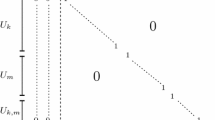Abstract
We introduce a new class of second-order cover inequalities whose members are generally stronger than the classical knapsack cover inequalities that are commonly used to enhance the performance of branch-and-cut methods for 0–1 integer programming problems. These inequalities result by focusing attention on a single knapsack constraint in addition to an inequality that bounds the sum of all variables, or in general, that bounds a linear form containing only the coefficients 0, 1, and –1. We provide an algorithm that generates all non-dominated second-order cover inequalities, making use of theorems on dominance relationships to bypass the examination of many dominated alternatives. Furthermore, we derive conditions under which these non-dominated second-order cover inequalities would be facets of the convex hull of feasible solutions to the parent constraints, and demonstrate how they can be lifted otherwise. Numerical examples of applying the algorithm disclose its ability to generate valid inequalities that are sometimes significantly stronger than those derived from traditional knapsack covers. Our results can also be extended to incorporate multiple choice inequalities that limit sums over disjoint subsets of variables to be at most one.
Similar content being viewed by others
References
Balas E. (1975). Facets of the Knapsack Polytope. Math. Program. 8: 146–164
Crowder H.P., Johnson E.L. and Padberg M.W. (1983). Solving large-scale zero-one linear programming problems. Oper. Res. 31: 803–834
Geoffrion A.M. (1969). An improved implicit enumeration approach for integer programming. Oper. Res. 17: 437–454
Glover F. (1965). A multiphase-dual algorithm for the zero-one integer programming problem. Oper. Res. 13: 879–919
Glover F. (1971). Flows in arborescences. Manage. Sci. 17: 568–586
Glover F., Sherali H.D. and Lee Y. (1997). Generating cuts from surrogate constraint analysis for zero-one and multiple choice programming. Comput. Optim. Appl. 8(2): 152–172
Gu Z., Nemhauser G.L. and Savelsbergh M.W.P. (1998). Cover inequalities for 0–1 linear programs: computation. INFORMS J. Comput. 10: 427–437
Hammer P.L., Johnson E.L. and Peled U.N. (1975). Facets of regular 0–1 polytopes. Math. Program. 8: 179–206
Hanafi, S.: Contribution à la résolution de problèmes duaux de grande taille en optimisation combinatoire. Ph.D. Thesis, University of Valenciennes, France (1993)
Hanafi, S., Glover, F.: Exploiting nested inequalities and surrogate constraints. Research Report, University of Valenciennes, France, and University of Colorado, Boulder, CO, USA (2005)
Hooker, J.N.: Logic-based methods for optimization. In: Borning, A. (ed.) Principles and Practice of Constraint Programming. Lecture Notes in Computer Science, Vol. 874, pp. 336–349 (1994)
Hooker J.N. and Osorio M.A. (1999). Mixed logical/linear programming. Discrete Appl. Math. 96–97: 395–442
Nemhauser G.L., Savelsbergh M.W.P. and Sigismondi G.S. (1994). MINTO, a mixed INTeger optimizer. Oper. Res. Lett. 15: 47–58
Nemhauser G.L. and Wolsey L.A. (1999). Integer and Combinatorial Optimization. 2nd edn. Wiley, New York
Osorio M.A., Glover F. and Hammer P. (2002). Cutting and surrogate constraint analysis for improved multidimensional knapsack solutions. Ann. Oper. Res. 117: 71–93
Savelsbergh M.W.P. (1994). Preprocessing and probing for mixed integer programming problems. ORSA J. Comput. 6: 445–454
Sherali H.D. and Lee Y. (1995). Sequential and simultaneous liftings of minimal cover inequalities for generalized upper bound constrained knapsack polytopes. SIAM J. Discrete Math. 8(1): 133–153
Spielberg, K., Guignard, M.: A sequential (Quasi) hot start method for BB (0, 1) mixed integer programming. Mathematical Programming Symposium, Atlanta, GA (2000)
Vasquez M. and Vimont Y. (2005). Improved results on the 0–1 multidimensional knapsack problem. Eur. J. Oper. Res. 165: 70–81
Wolsey L.A. (1975). Faces for a linear inequality in 0–1variables. Math. Program. 8: 165–178
Author information
Authors and Affiliations
Corresponding author
Rights and permissions
About this article
Cite this article
Glover, F., Sherali, H.D. Second-order cover inequalities. Math. Program. 114, 207–234 (2008). https://doi.org/10.1007/s10107-007-0098-4
Received:
Accepted:
Published:
Issue Date:
DOI: https://doi.org/10.1007/s10107-007-0098-4
Keywords
- Integer programming
- Knapsack cover inequalities
- 0–1 Pre-processing
- Nested cuts
- Surrogate constraints
- Facets




